The emissions test defeat device problem in Europe is not about VW
Blog
Fiat-Chrysler, Renault-Nissan . . . who might be next?
The news earlier this month that the U.S. EPA had issued a Notice of Violation to Fiat-Chrysler for failing to inform the agency of several software “devices” that alter the behavior of the emissions controls on some diesel SUVs, followed the very next day by reports that French prosecutors are investigating Renault-Nissan for possible emissions test cheating, had some wondering if these were opening acts of another Volkswagen-type story. It’s too soon to tell about that. But the data that keeps coming on performance gaps between official emissions measurements for diesel passenger vehicles and on-road emissions in everyday operation would justify the most cautious gambler in betting that these are not the last stories we’ll see of automakers using defeat devices to beat emissions tests. The problem was never just about VW, and it’s probably not just about Fiat Chrysler Automobiles (FCA) or Renault-Nissan, either.
Take, for example, the results of French government tests on diesel cars following the first dieselgate revelations. In late 2015, the Ministry of Environment commenced a diesel vehicle screening project to test for excess nitrogen oxide (NOx) emissions. We summarized the results of the government’s first report here. In a second phase of the testing program, additional diesel cars were added (for a total of 86 vehicles, from 24 manufacturers), manufacturer and model names were revealed, and the report was amended to include carbon dioxide (CO2) emissions. The final report was published on July 29, 2016.
The program aimed to reveal any variation in NOx and CO2 emissions in a cold-start versus hot-start test, and in on-road versus laboratory-measured emissions. To that end, the vehicles were put through three tests, labeled D1, D2, and D3:
- A modified version of the official type-approval test, with the certification cycle (the New European Driving Cycle, NEDC) slightly altered to evade any defeat device that might be watching for indications that a car was being driven over the test cycle (D1).
- A test that differs from the type-approval test in that the first section does not begin with a cold start, but rather is driven with the engine warm (D2).
- A test in which the vehicle is equipped with a portable emissions measurement system (PEMS) and driven over the NEDC on a track; like D1, this test (D3) could evade a defeat device that was watching for indications that a car was mounted on a chassis dynamometer in a laboratory (such as the steering wheel never turning).
NOx emissions
As this chart shows, 65% of all cars tested had higher NOx emissions on the Extra-Urban Driving Cycle (EUDC, last part of the NEDC) when starting with a hot engine rather than a cold one. Approximately 85% of Euro 5 and 51% of Euro 6 diesel cars showed increased emissions during a hot start. The largest increase came from the Euro 5 Jeep Cherokee (Fiat-Chrysler group), with emissions increasing by a factor of 11 from the cold to hot start.
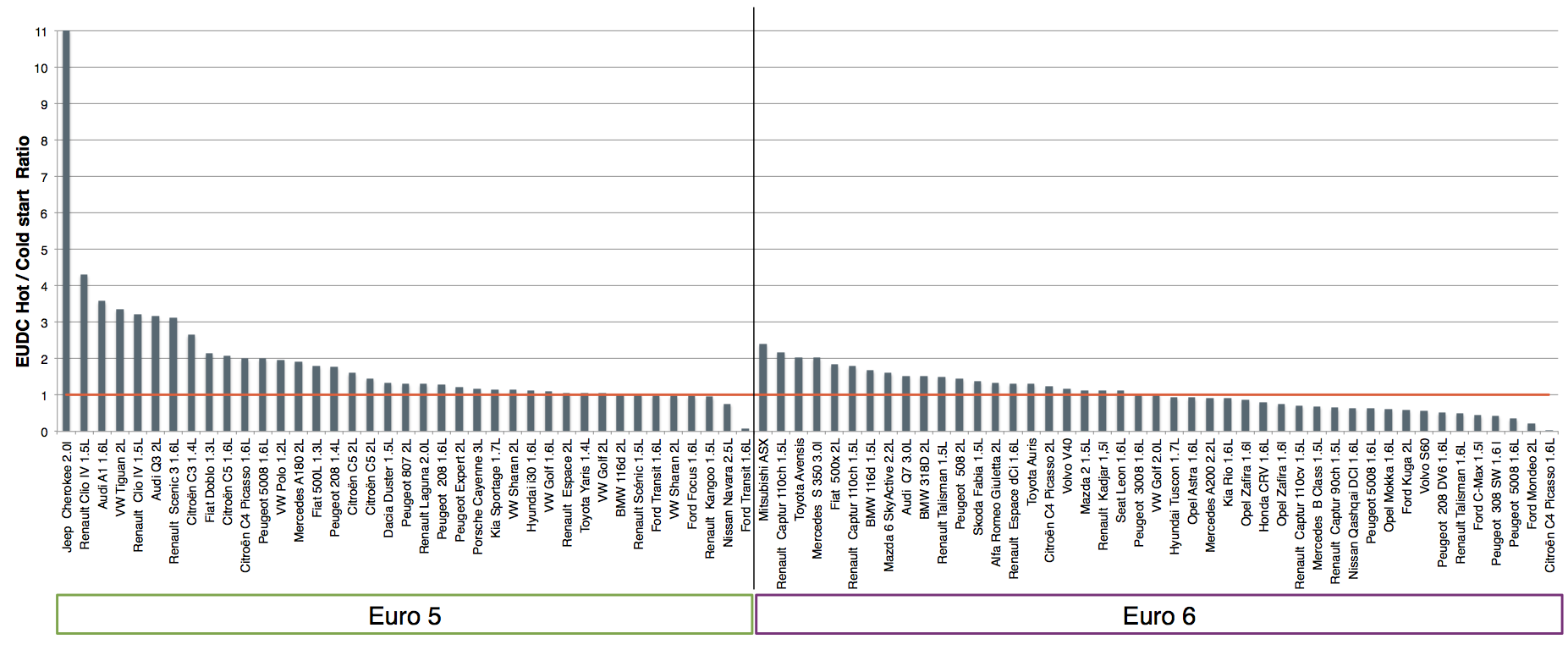
Ratio of hot-start to cold-start NOx emissions under the EUDC (high-speed portion of the NEDC) in the French government D2 test.
There is no technical rationale for this behavior. Emissions should be lower on a test that begins with a hot-start because the emission controls are then up to operating temperature and functioning optimally. At the very least NOx emissions in the last portion of a hot-start test with a properly functioning emissions-control system should be no higher than in a cold-start test. And in fact a number of the Euro 6 cars tested did have lower emissions during the hot-start test.
The two charts below show results of the D1 and D3 tests for Euro 5 and Euro 6 cars. The average NOx emissions level of all Euro 5 cars in the D3 (on-track, emissions measured by PEMS) test was 609 mg/km; this is 3.4 times the regulatory limit of 180 mg/km, which was met (or almost met) for all cars under the controlled laboratory test conditions of the D1 test. For Euro 6 cars, the average NOx emissions level in the on-track test was 410 mg/km, which is 5.1 times the type-approval test limit (80 mg/km).
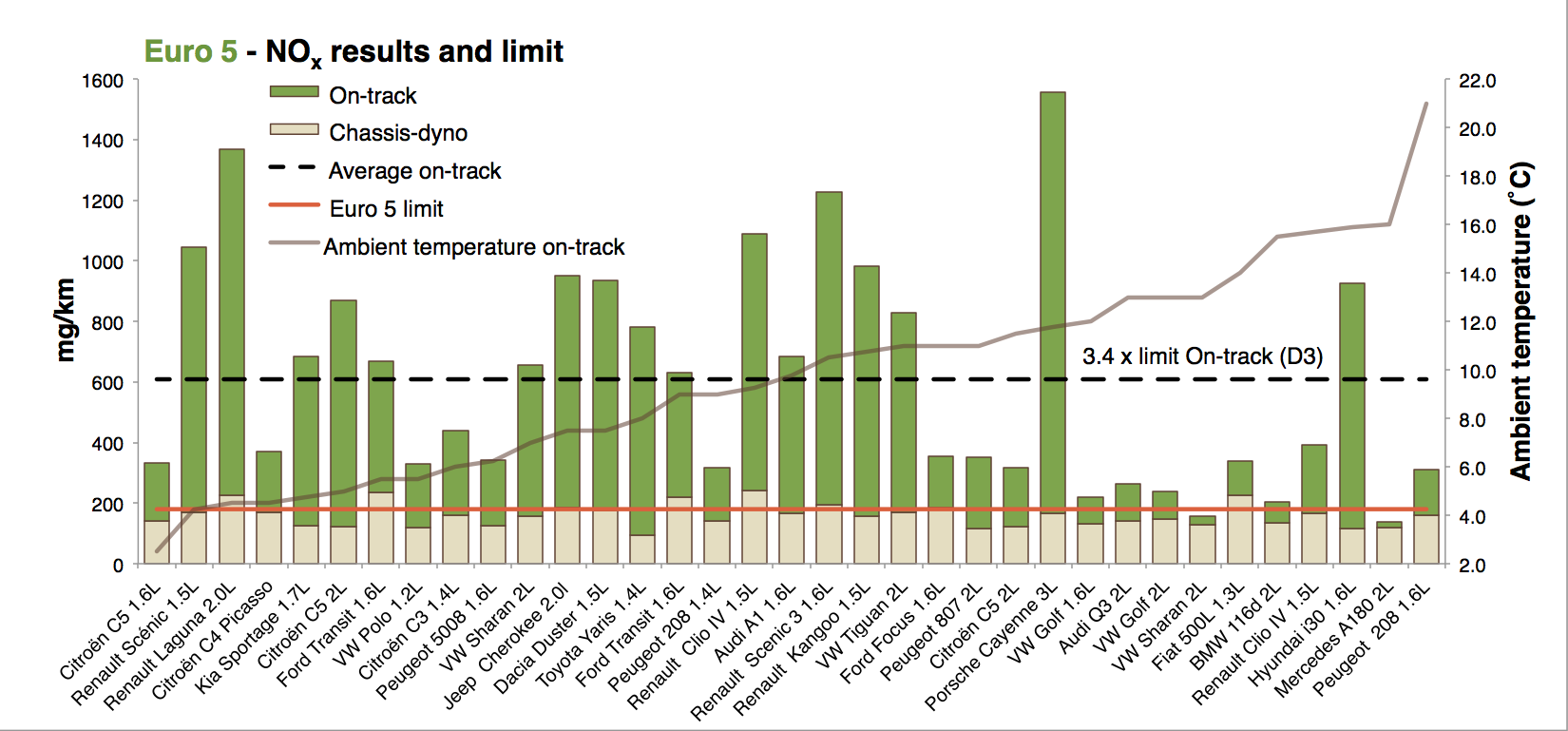
Euro 5 vehicles (commercial vehicles excluded): NOx emissions on laboratory/chassis-dyno (D1) and on-track (D3) tests (cold-start).
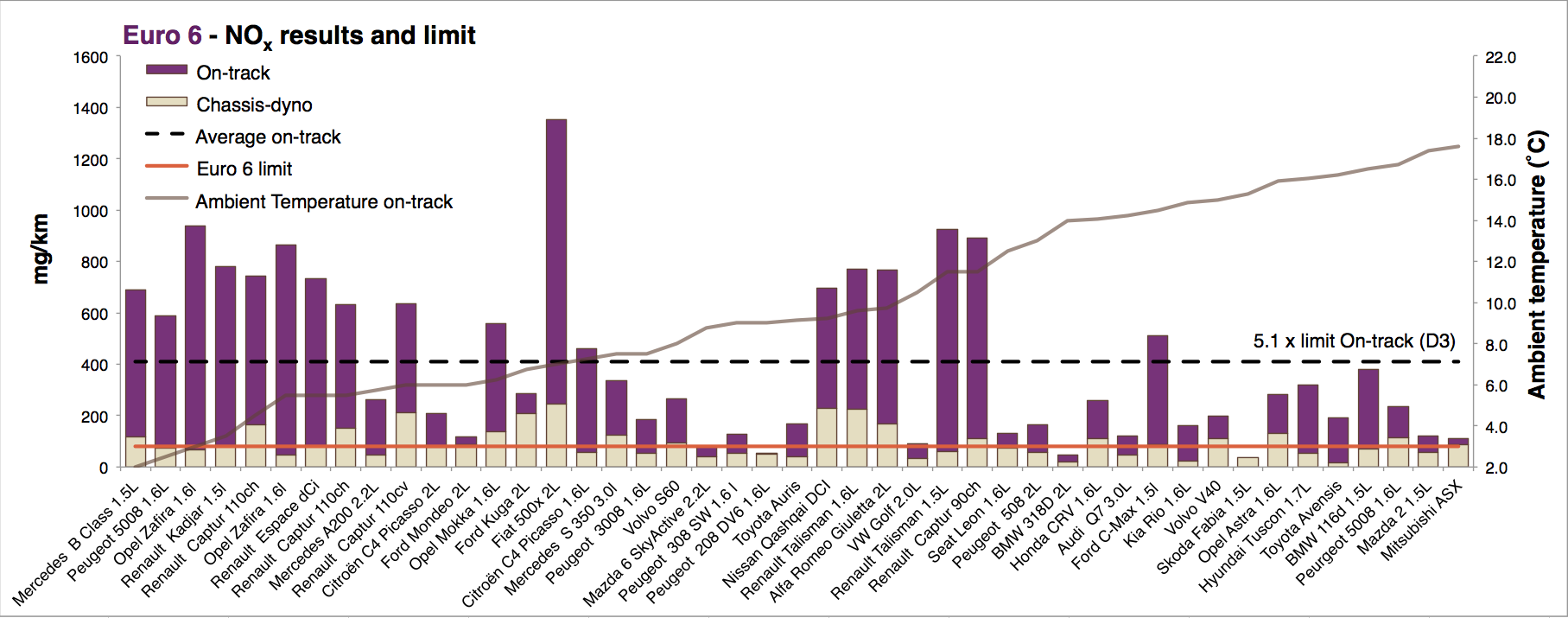
Euro 6 vehicles: NOx emissions on laboratory/chassis-dyno (D1) and on-track (D3) tests (cold-start).
One potential reason for the discrepancy is that the on-road tests were conducted with ambient temperatures varying from 2°C to 21°C. A number of manufacturers have already admitted that they reduce the operation of elements of the emissions control system at certain ambient temperatures, taking advantage of a provision in the regulation that permits that behavior when necessary to protect the engine. But, again, there is no genuine engineering justification for this at the temperatures at which the manufacturers doing it, which fall well within normal averages in Europe. And, again, the fact that some of the tested vehicles were able to maintain low emissions in colder ambient temperatures during the French government tests casts doubt on arguments that this type of control strategy is necessary.
The Fiat-Chrysler and Renault-Nissan Euro 6 vehicles in the French tests provide dramatic examples of the problem, showing extremely high NOx emission levels (e.g., the Fiat 500X, with emissions 17 times the limit) in real-word conditions at temperatures close to Europe’s yearly average.
CO2 emissions
The CO2 emission results from the French testing program indicate that nearly all vehicles tested had CO2 levels higher than their type-approval figures, regardless of how the vehicles were tested. Notably, the vehicles tested failed to match their type-approval CO2 values even when the testing conditions of the type-approval procedure were replicated (including coastdown settings provided by vehicle manufacturers).
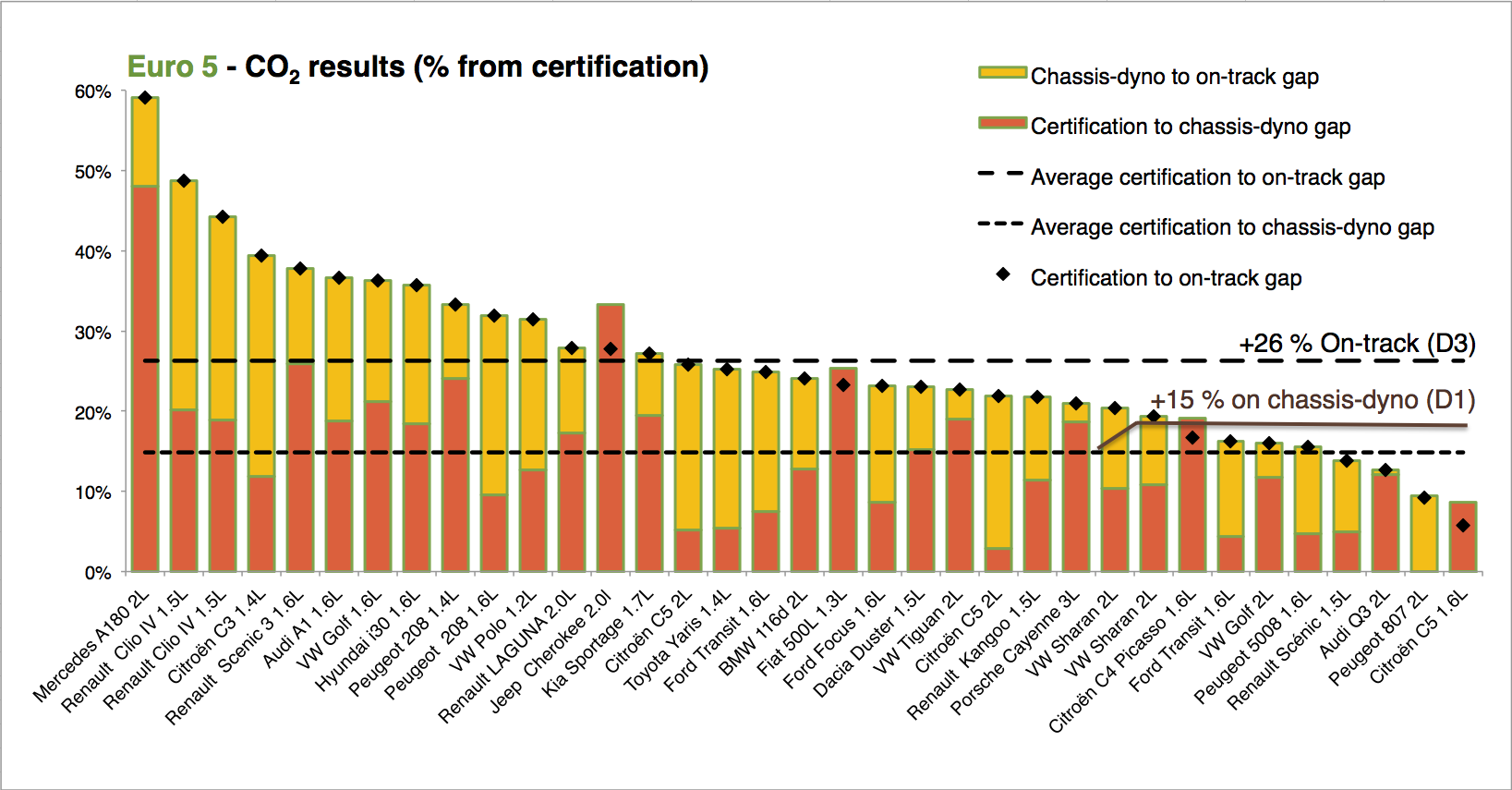
Euro 5 vehicles: Discrepancy between type-approval CO2 emission levels and French laboratory and on-track NEDC testing.
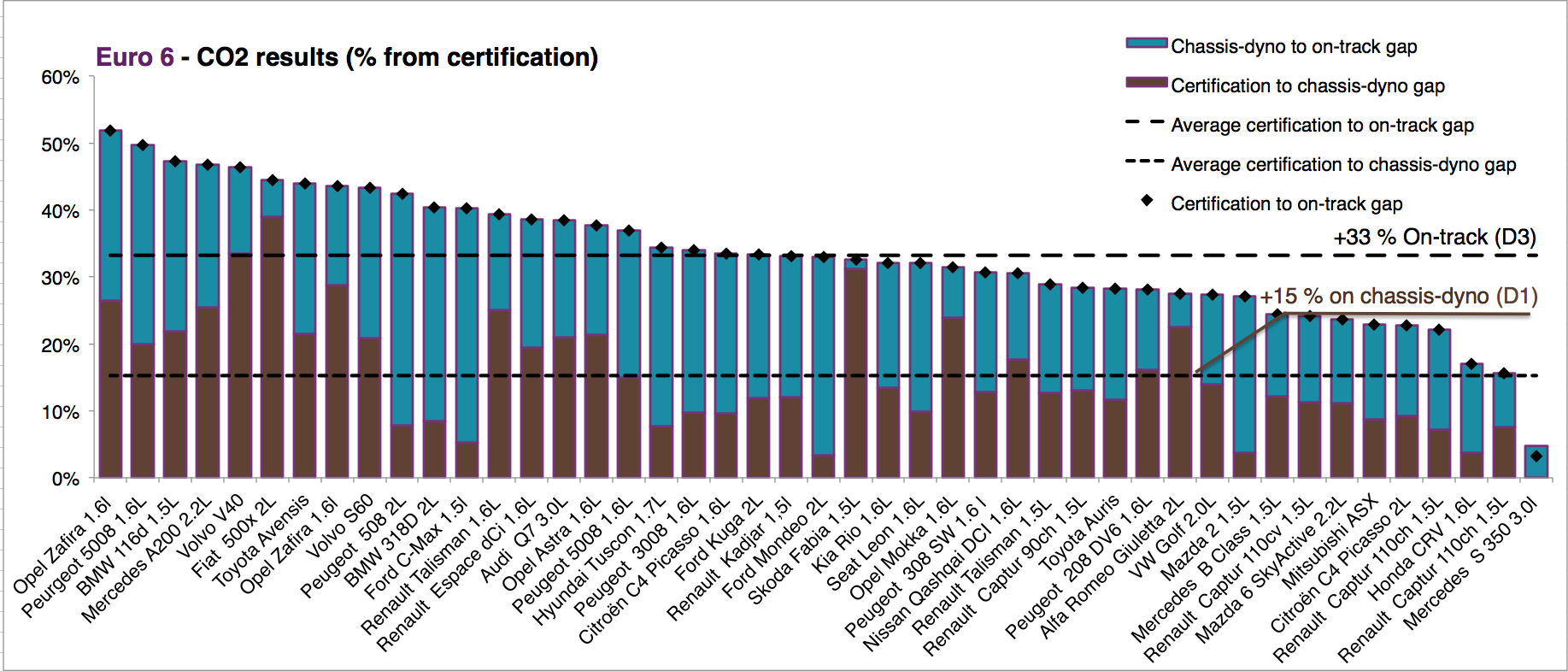
Euro 6 vehicles: Discrepancy between type-approval CO2 emission levels and French laboratory and on-track NEDC testing.
The most likely explanation for this discrepancy is that the current test procedure permits a number of optimizations prior to and during a CO2 type-approval test. These optimizations include fully charging the car’s battery prior to the start of a test and starting the test in second gear. (More details can be found in the French report).
As these charts show, there was, on average, a 15% difference between CO2 emissions measured over the D1 test and the official type-approval values. There was an average 26% and 33% difference between the D3 test and the official type-approval values for Euro 5 and 6 vehicles, respectively. This is consistent with our recent analysis, which shows that the gap between type approval and real-world CO2 is growing over time.
Responses to the testing results
The French Ministry report claims that the testing program did not discover any illegal defeat devices, a conclusion that seems at odds with the data presented. As we’ve shown in briefings and blogs (here, here), ambiguous implementation guidance in the current Euro 5/6 regulation has allowed manufacturers to exploit provisions in the defeat-device prohibition that provide for exemptions under certain operating conditions. Often they have done so by claiming that fully controlling NOx emissions outside of the narrowly defined boundary conditions of the type-approval test would risk damage to the vehicle’s engine. And indeed, the explanations offered by vehicle manufacturers in the final version of the French report point mostly to that argument to justify the high real-world NOx emissions revealed in the French tests. The numerous counterexamples contained in the report itself should be enough to call that explanation into question.
Both Fiat-Chrysler and Renault-Nissan had announced updates to their upcoming engine calibration strategies and a voluntary service action for cars already on the road to improve their overall NOx emissions on a wider range of driving conditions. The current investigations might not prove that FCA or Renault-Nissan used defeat devices per se, but these recalls confirm that automakers can do more than just the minimum necessary to comply with the letter of the law and reduce emissions in real-world conditions. Beginning next September, we will need to keep a close eye on how things are working under the new Real Driving Emissions regulation if we want to see that manufacturers honor the spirit of that law as well as the letter of it.